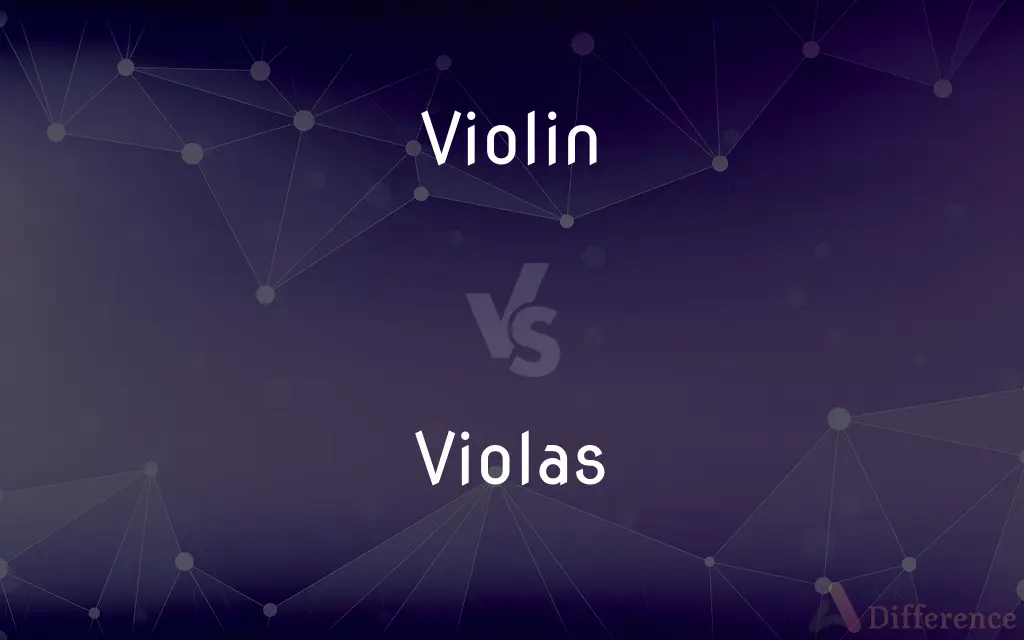Violin vs. Violas — What's the Difference?
By Urooj Arif & Fiza Rafique — Published on April 15, 2024
Violins are known for their higher pitch and smaller size compared to violas, which have a deeper, mellower sound due to their larger body and longer strings.

Difference Between Violin and Violas
Table of Contents
ADVERTISEMENT
Key Differences
The violin, often considered the soprano voice of the string family, is renowned for its bright, high-pitched sound. It typically plays the melody in string ensembles, captivating audiences with its expressive capabilities. In contrast, the viola, slightly larger in size, offers a richer, warmer tone that falls between the violin and the cello in the string section. This unique sound quality stems from its longer strings and larger body, which contribute to its deeper voice.
Violins are tuned in perfect fifths, with strings G, D, A, and E being standard, which allows for a wide range of notes and versatility in playing different music genres. Violas, on the other hand, are also tuned in perfect fifths but have a lower range with C, G, D, and A strings. This tuning difference is crucial for the viola's ability to produce its characteristic warm and mellow tones, distinguishing it from the brighter and more piercing sound of the violin.
In terms of physical dimensions, violins are generally more compact and lighter than violas, making them suitable for players of all ages, including children. The smaller size of the violin contributes to its agility and ease of playing fast passages. Violas, with their larger size, require a slightly different playing technique, often demanding more from the player in terms of arm reach and finger spacing, which can affect playability and comfort.
The role of the violin in orchestras and ensembles is typically more prominent, often leading with the main melodies and engaging in intricate solos. Violas, while not as frequently spotlighted for solos, play a crucial role in providing depth and richness to the harmonic texture, bridging the gap between the violins and lower string instruments like cellos and basses.
Despite their differences, both violins and violas are essential to the depth and complexity of orchestral and chamber music, each contributing its unique voice and character to the ensemble. Whether it's the sparkling clarity of the violin or the warm embrace of the viola, both instruments are cherished for their distinctive sounds and the emotional depth they bring to music.
ADVERTISEMENT
Comparison Chart
Pitch Range
Higher, soprano voice in string family
Lower, alto voice in string family
Size
Smaller, more compact
Larger, longer body and strings
Tuning
G, D, A, E
C, G, D, A
Sound Quality
Bright, expressive
Rich, mellow
Role in Ensembles
Often leads with melody, prominent solos
Provides harmonic depth, less frequent solos
Compare with Definitions
Violin
Smallest and highest-pitched in the string family.
The violin section added sparkling brightness to the orchestra.
Violas
Larger than a violin, with a deeper pitch.
The violist adjusted to the instrument's larger size for comfortable playing.
Violin
A high-pitched string instrument, often leading melodies.
The violin's solo captivated the audience with its expressive range.
Violas
Tuned a fifth below the violin: C, G, D, A.
The unique tuning of the viola contributes to its distinctive sound.
Violin
Integral to both solo and ensemble performances.
The violin soloist showcased the instrument's versatility across musical genres.
Violas
A string instrument with a rich, mellow tone.
The viola's warm sound added depth to the string quartet.
Violin
Tuned in perfect fifths: G, D, A, E.
The violinist tuned her instrument carefully before the concert.
Violas
Requires a wider finger spread due to its size.
Viola players often develop a strong technique to manage the larger fingerboard.
Violin
Known for agility and fast passages.
The violin piece required rapid finger movements and bowing techniques.
Violas
Balances melody and harmony in ensembles.
The viola section provided crucial harmonic support in the orchestra.
Violin
A stringed instrument played with a bow, having four strings tuned at intervals of a fifth, an unfretted fingerboard, and a shallower body than the viol and capable of great flexibility in range, tone, and dynamics.
Violas
A stringed instrument of the violin family, slightly larger than a violin, tuned a fifth lower, and having a deeper, more sonorous tone.
Violin
A small unfretted stringed instrument with four strings tuned (lowest to highest) G-D-A-E, usually held against the chin and played with a bow.
When I play it like this, it's a fiddle; when I play it like this, it's a violin.
Violas
An organ stop usually of eight-foot or four-foot pitch yielding stringlike tones.
Violin
Any instrument of the violin family, always inclusive of violins, violas, and cellos and sometimes further including the double bass.
The string quartet, one of the most popular groupings in chamber music, is composed entirely of violins: two violins proper, one viola, and one cello.
Violas
Any of various plants of the genus Viola, which includes the violets and pansies, especially certain ornamental varieties that are usually more compact than pansies and have smaller flowers without a blotch on the petals.
Violin
A small instrument with four strings, played with a bow; a fiddle.
Violin
Bowed stringed instrument that is the highest member of the violin family; this instrument has four strings and a hollow body and an unfretted fingerboard and is played with a bow
Common Curiosities
Can violinists easily switch to playing viola?
While many skills are transferable, the switch requires adjustments in technique due to the viola's larger size and different tuning.
Why is the viola less prominent in solos than the violin?
The viola's role traditionally focuses on adding harmonic depth, although contemporary compositions increasingly feature the viola in solos.
Is reading music the same for violin and viola?
Violin music is written in treble clef, while viola music uses the alto clef, which requires violists to learn a different clef reading.
Do violins and violas use the same type of bow?
Yes, the bows are similar, but viola bows can be slightly heavier to accommodate the thicker strings and larger body of the viola.
How does the physical size of the instrument affect playing technique?
The larger size of the viola demands a wider finger stretch and different arm positioning, affecting the overall playing technique.
What factors influence the choice between playing violin and viola?
Personal preference for the instrument's sound, physical comfort with its size, and the desired role in ensembles can all influence the choice.
Do violins and violas come in different sizes?
Yes, both instruments are available in various sizes to accommodate players of different ages and physical statures.
Is the repertoire for violas as extensive as for violins?
While the violin repertoire is more extensive due to its longer history as a solo instrument, the viola has a growing body of solo and chamber music.
Can the violin and viola be part of the same musical compositions?
Yes, both instruments commonly play together in a wide range of musical ensembles, from duets to large orchestras, complementing each other's sounds.
What is the main difference between a violin and a viola?
The main difference lies in their size and pitch range; violins are smaller and higher-pitched, while violas are larger with a deeper, warmer sound.
Why is viola music written in alto clef?
The alto clef is better suited to the viola's range, allowing for easier reading and notation of its music within its middle pitch range.
Are electric versions of violins and violas available for contemporary music?
Yes, electric violins and violas are used in contemporary and experimental music genres, offering amplified sound and effects capabilities.
How do the sound qualities of violins and violas complement each other in an ensemble?
The bright, expressive sound of violins blends with the warm, rich tones of violas to create a full, balanced sound in string ensembles.
How does the choice of strings affect the sound of violins and violas?
The type and quality of strings can significantly influence the instrument's sound, with different materials producing varying tones and responses.
Are there specific music genres where violas are more prominent than violins?
While both instruments are versatile, violas may be featured more in chamber music where their rich tone can be more prominently showcased.
Share Your Discovery

Previous Comparison
1G vs. 2G
Next Comparison
Testing vs. TemptationAuthor Spotlight
Written by
Urooj ArifUrooj is a skilled content writer at Ask Difference, known for her exceptional ability to simplify complex topics into engaging and informative content. With a passion for research and a flair for clear, concise writing, she consistently delivers articles that resonate with our diverse audience.
Co-written by
Fiza RafiqueFiza Rafique is a skilled content writer at AskDifference.com, where she meticulously refines and enhances written pieces. Drawing from her vast editorial expertise, Fiza ensures clarity, accuracy, and precision in every article. Passionate about language, she continually seeks to elevate the quality of content for readers worldwide.













































